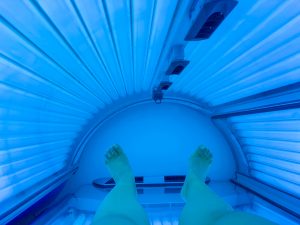Lots of people like to use tanning beds, and researchers estimate that about one in every three Caucasian high school girls use tanning beds. Although it’s common for people to think that it’s safer to tan indoors in a tanning bed, that isn’t true. Both natural and artificial ultraviolet rays can cause skin cancer.

Tanning Beds and Skin Cancer
Tanning beds emit two types of ultraviolet rays that can deepen the pigmentation in skin. Both of these types of UV rays can damage the skin.
- UVB rays generally penetrate only the epidermis, which is the upper layer of the skin. This causes sunburn.
- UVA rays penetrate below the epidermis, stimulating the pigmented skin cells to produce melanin, which results in a tan.
- Researchers are seeing indications that UVA rays cause most skin cancers. UVA rays also cause premature aging and wrinkles.
Tanning Bed Safety Myths
It’s a common myth that tanning in a tanning bed is safer than being outdoors in the sun. The truth is that both outdoor sun exposure and indoor tanning bed exposure are dangerous for the skin.
- Tanning beds use mostly artificial UVA rays, which are the type of rays that cause most skin cancers. Many people mistakenly think that UVA rays are safer.
- People also think that tanning in a tanning bed can provide a “base tan” to prevent later burns. But a base tan can be equally as dangerous as a sunburn.
Why Tanning Beds Are Dangerous for Teenagers
Tanning beds are dangerous for everyone, but teenagers and young adults who use tanning beds regularly can be especially vulnerable to skin damage.
- Early exposure to tanning beds can increase a person’s risk of developing melanoma.
- Melanoma is a common type of cancer for teenagers and young adults between the ages of 15 and 29.
- Melanoma can spread to other organs. If it reaches the lymph nodes, you have only a 62 percent chance of living for five years.
Learn More About Skin Cancer and Skin Health
- What Is Skin Cancer? Skin cancer is the most prevalent type of cancer in the United States.
- Skin Cancer: Skin cancer happens when the skin is exposed to too much ultraviolet light.
- Skin Cancer (Including Melanoma): Types of skin cancer include melanoma, basal cell carcinoma, and squamous cell carcinoma.
- Skin Cancer in Skin of Color: People with more pigmentation in their skin may reach an advanced stage of skin cancer without experiencing noticeable symptoms.
- The Surgeon General’s Call to Action to Prevent Skin Cancer: Skin cancer rates are going up, so it’s important for people to understand how to stay safe from the damage caused by UV rays.
- Skin Cancer: Skin cancer begins in the skin cells, but some types of skin cancer can spread to other organs.
- About Skin Cancer: Of the Americans who reach age 65, an estimated 40 to 50 percent will have some type of skin cancer at least once.
- Take Steps to Prevent Skin Cancer: Preventing skin cancer involves protecting your skin from sources of ultraviolet rays.
- Overview of Skin Cancer: Applying sunscreen with a sun protection factor of at least 30 will help protect your skin from skin cancer.
- Information About Skin Cancer: Skin cancer is more prevalent than breast, colon, lung, and prostate cancers combined in the United States.
- Skin Cancer Prevention: Melanoma is more deadly than the other two types of skin cancer.
- The Risks of Tanning: There’s a link between severe sunburns and developing melanoma, which is the most serious type of skin cancer.
- The Truth About Tanning Beds: Tanning beds are linked to skin cancer because they emit ultraviolet rays.
- Indoor Tanning: When you tan in a tanning bed, your skin is exposed to both UVA and UVB rays, which can damage your skin and lead to skin cancer.
- Skin Cancer Facts: It’s estimated that about one in every five Americans will develop some type of skin cancer during their life.
- Three Ways to Protect Your Kids From Skin Cancer: Not only are tanning beds dangerous for the skin, but they also increase people’s risk of developing cataracts.
- Ten Skin Cancer Myths Debunked: Don’t believe the myth that tanning beds are safer than the sun; tanning beds also emit UV radiation.
- Skin Cancer and Sun Safety: Even people with dark skin can get sunburns, and a sunburn indicates that your skin has been damaged by the sun.
- A Dangerous Combination for Youths: Indoor Tanning and Skin Cancer: Tanning has been linked with an increased risk of melanoma for women under age 30.
- Tanning Beds Linked to Non-Melanoma Skin Cancer: The risks of using tanning beds increase for younger users.
- Indoor Tanning: Both indoor and outdoor tanning are dangerous because both involve UV radiation.
- Looks Can Kill: The Dark Side of Indoor Tanning and What States Need to Do to Help Protect Young Adults From This Deadly “Glow”: Following the societal norm of tanning can have life-threatening results.
- The Harms of Tanning Beds: Having a year-round tan from a tanning bed can be very harmful to the skin.
- Who Gets Skin Cancer? No one is safe from skin cancer, but people who regularly tan in tanning beds have a higher risk of developing the disease.





